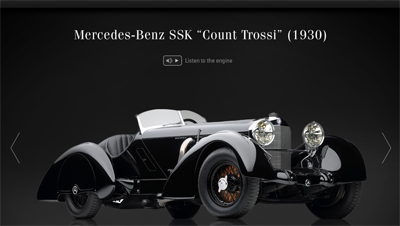Luxury Daily quoted me extensively this week in the article entitled "How luxury marketers can entice purchase by using sound in digital marketing." Rachel Lamb's article details how luxury brands are using sound to communicate with consumers via the Internet. I was thrilled when I was asked to provide my opinion as an "industry expert". I was able to provide a lot of detailed information about the use of sound in relation to luxury website design, so if you are interested, be sure to check out the article on my website design blog: www.newyorkcitywebsitedesigner.com
How luxury marketers can entice purchase by using sound in digital marketing
Posted By Rachel Lamb
On July 21, 2011 @ 4:45 am
www.LuxuryDaily.com
Since luxury marketers have already lost the tactile sense when using digital marketing, adding sound where it counts can truly help them convince affluent consumers to buy their products, according to experts. Brands that carefully use sound online and in mobile applications can entice consumers to buy products by enveloping them in as many senses as possible to mock an in-person experience. Since touch and smell cannot be used in digital efforts, sound is the most effective.
 |
| Ferrari's engine can be heard online |
“The more senses that you can engage, the more possibility you have to trace your brand into their mind,” said Jack Burke, president of Sound Marketing Inc., Branson, MO.
“Brands should not use sound gratuitously – there should be a reason and purpose to the sound,” he said. “In many cases, the easiest way for a luxury brand or any brand to engage is with sound used as an informational resource. [Luxury products] are expensive, and it’s a big deal to some people. Sound and educational resources help to engage them and to help them feel comfortable about the decision that they are making.”
Revving up
Marketers who arguably use sound most effectively are automakers. Whether it is with a video of a car zooming by or with a sound of a honk, consumers are better able to visualize the experience of being in a car, even if they are just researching on their computers. For instance, Aston Martin and Ferrari allow consumers to hear many features of the cars on their Web sites.
When consumers click on an Aston Martin vehicle, they are able to choose different sound settings , such as engine start, 0-120 miles-per-hour acceleration, engine revving, drive-by fast and pass by.
Aston Martin also employs this strategy in its Aston Martin Explore mobile app, where consumers can tap on the ignition to hear the engine rev.Additionally, when consumers are taking a virtual tour of a Ferrari on the automaker’s Web site, they can click on the ignition and listen to the car start up.
“I think you have to be really careful about how you incorporate sound into a Web site,” said Andrea Bertola, owner of The New York Website Designer, New York. “There is nothing more jarring than visiting a Web site and jumping five feet out of your chair when the sound unexpectedly blares out of your speakers."
“In retrospect, sound can absolutely enhance a Web site if the user has the option to select it,” she said. “Humans are curious by nature, use it to your advantage.
“You always want your Web site user to feel like they are in control.”
Apparel and accessories designer Ralph Lauren also uses this tactic for his personal interests.
Known car enthusiast Mr. Lauren has dedicated a section of the brand’s Web site to the L’Art de L’Automobile exhibition in France.Consumers can visit the exhibit online and scroll through old-fashioned models from Ferrari, Bugatti, Mercedes-Benz and Bentley. By clicking on the various models, they can hear what the engines sound like when the car starts, when it is driving away and when it is passing nearby. This cycle plays in a loop for each vehicle. Consumers are able to hear what it sounds like when they are both inside and outside of these cars.
Subtle sounds
Luxury marketers other than automakers are creatively tapping sound to enhance digital experience. For instance, Christian Dior is using subtle sound imagery with its Miss Dior Cherie campaign starring actress Natalie Portman.
The brand has a microsite dedicated to the fragrance. When consumers enter it, they are encouraged to “pull” on the bow of a box, tipping it over and spilling its contents.
Consumers can hear the gentle thump of the box hitting the table and hear its contents rolling out.
The process repeats with the sound of more boxes tipping over and a ribbon being pulled, as well as watching and listening to a record roll along the countertop and spinning and settling on the surface.
“Many people are auditory in nature and obtain what they hear more so than what they read,” Sound Marketing’s Mr. Burke said.
“If you put something in writing and have the opportunity to put it in sound or video, then you lose an opportunity to engage with the customer,” he said. “The more senses you engage, the better off you are. That’s the strength of the auditory sense. To not use it is to short-sheet your marketing efforts.”
Indeed, many luxury brands can use sound to evoke the feeling of luxury. For instance, retailers could use the sound of crinkling tissue paper or luxury hotels could play the same gentle music on their Web sites as they do in their lobbies or elevators.
“A good Web site should provide an experience for the user,” New York Website’s Ms. Bertola said. “By indulging their senses, we are able to captivate them on different levels,” she said. “By doing so, the brand is offering a more memorable experience that will leave a lasting impression.”
Article printed from Luxury Daily: http://www.luxurydaily.com
URL to article: http://www.luxurydaily.com/how-luxury-marketers-can-entice-purchase-by-using-sound-in-digital-marketing/
.

